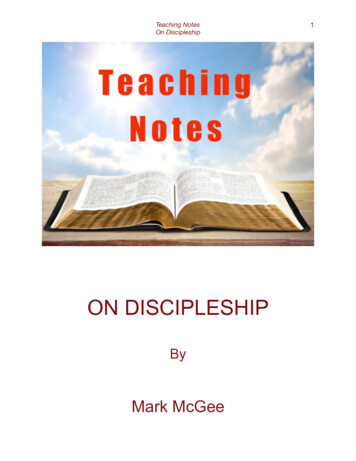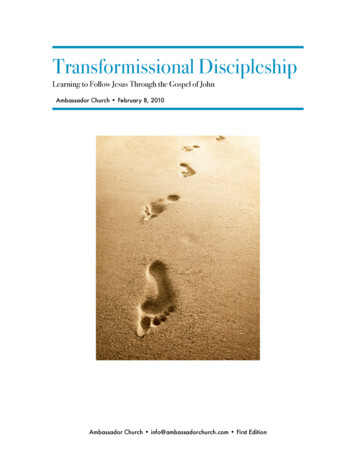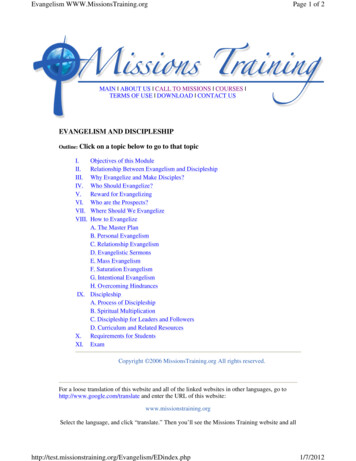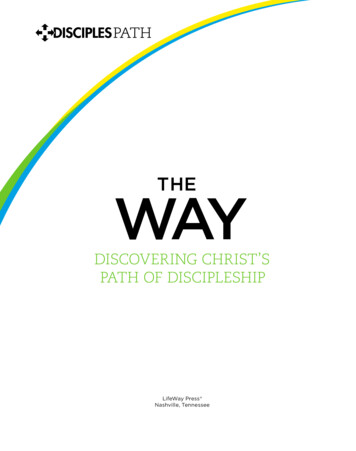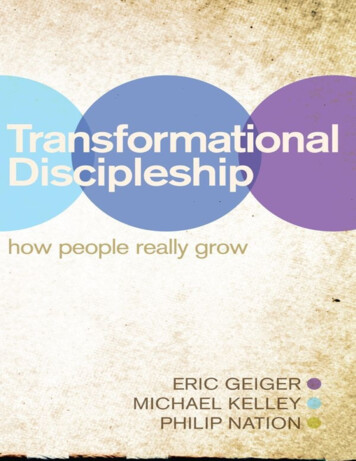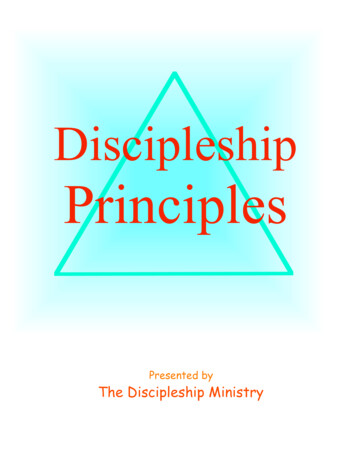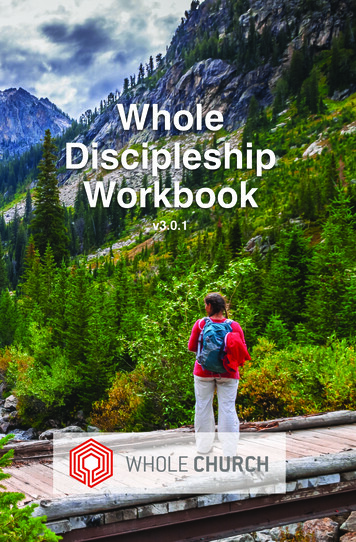
Transcription
WholeDiscipleshipWorkbookv3.0.1WHOLE CHURCH
WHOLE DISCIPLESHIP WORKBOOKIntroductionAll churches share a common mission to make disciples ofJesus Christ for the transformation of the world. This two-partmission transforms Jesus’s call to “Love the Lord your God with allyour heart and with all your soul and with all your strength and withall your mind and love your neighbor as yourself” into an actionstatement for the church. How do we live out the call to love Godand neighbor? We make disciples and strive to transform ourcommunities and world.Making disciples will not happen by accident. It must be theintentional work of each local church. The goal of this booklet is tohelp you begin to articulate a clear path of discipleship for peoplein your congregation.At baptism, we are initiated into Christian community. Vows aremade, either by individuals themselves or by others on their behalf,to be on a journey of discipleship. At each baptism we ask thewhole congregation, “Will you nurture one another in the Christianfaith and include these persons now before you in your care?”Developing an intentional discipleship system is the most importantways a congregation can live this commitment out.Each congregation will have its own flavor of discipleshipsystem. It will vary based on your location, context, and the giftsand graces present in your community. This variation is healthyand as God intends. To be a vibrant movement, Christianity needsa diversity of churches.All discipleship activities should relate in some way to what weknow as the means of grace.1 Meaning, they should be practiceswhere we recognize and expect God’s grace to pervade in andthrough those who participate. This grace, in turn, strengthens andconfirms the faith of the individual.There are some common elements that should be part of anydiscipleship system. This booklet will walk you through developingeach element in a way that best fits your local wesleyan-means-of-gracev3.0.11
WHOLE DISCIPLESHIP WORKBOOKThose elements are: A clearly articulated definition of what a disciple is. A defined set of core practices expected of all disciples inthis community. On ramps for new participants to begin a journey ofdiscipleship. A system of Wesleyan small groups. A system of 1:1 discipleship guides (or triads). Local ministries of justice and mercy.As you can see, this list moves from aspirational to verypractical. An aspirational definition of discipleship is required andso are practical opportunities for discipleship to be developed. Atrue disciple-making church will have both.As you move through this booklet you may want to inviteadditional people to participate. The final goal is to develop adiscipleship system that can be widely embraced. It will take youmore than one session to complete this process.v3.0.12
WHOLE DISCIPLESHIP WORKBOOKA disciple is someone whose life is being transformed by the loveof God the creator, through the power of the Holy Spirit, and byfollowing the way of Jesus Christ.Part 1: Crafting a DefinitionBefore you can start building a discipleship system, you need aclear definition of what a disciple is. The above definition is offeredas a starting place. Any definition should be simple, no more thanone or two sentences, and in an active voice. Discipleship is notpassive, and your definition cannot be either. A good definition willbe self-explanatory and understandable by those not used tochurch language.The above definition comes from a strong Trinitarian influencewhich may or may not resonate with your faith community.Review the definition above and some or all of the followingpassages: v3.0.1Matthew 28:16-20Romans 12:1-18John 8:31-322 Timothy 2:2Luke 6:40Luke 9:23Luke 14:25-26John 3:32 Corinthians 5:173
WHOLE DISCIPLESHIP WORKBOOKG ROUP D ISCUSSIONHave each person write the words or ideas they feel are mostimportant from the passages on a whiteboard or large piece ofpaper. Review and identify any common elements. Write thembelow.Individually write a one- to two-sentence definition of discipleship,or adapt the definition from page three, and share aloud.As a group, develop your definition of discipleship, keeping thefollowing in mind: Is it short? One or two sentences. Will people remember it? Is it Trinitarian? The full expression of God should bepresent. Is it active? Discipleship is an ongoing journey that doesn’tend.Keep in mind your definition does not need to be timeless, it needsto be timely. It should line up with who you are as a communitytoday and where you want to go tomorrow. You should plan torevisit it occasionally to be sure it still serves you.v3.0.14
WHOLE DISCIPLESHIP WORKBOOKOUR DEFINITIONHow can you share this definition?A definition is not really valuable unless people know and embraceit. How can you share your definition? How can you educate thewider congregation on what it means to be a disciple, and how yourteam arrived at this definition?Task ListWhat do you need to do next to share your definition?What?v3.0.1Who?5By When?
WHOLE DISCIPLESHIP WORKBOOKPart 2: Discipleship GuidesTo help develop your discipleship system we will work throughthe list presented in the introduction. We will start by looking atsome specific elements that should be in place in any robustdiscipleship system. This does not mean they all have to be inplace on day one, but over time they should develop as the systemmatures.One to one discipleship guides are a tried and true method ofgrowing and deepening faith. Going by different names, the basicpremise is an intentional person-to-person relationship wherethere is regular contact between people. They are also sometimesconfigured as triads where three individuals act as guides to oneanother. They often begin for a set period of time, eight to tenweeks, with the option to extend longer. The set initial period allowsfor a graceful exit should one or both participants not wish tocontinue.Alcoholics Anonymous has put this process to great usethrough what it calls “sponsors.” 2 In fact, AA began as a 1:1intentional relationship between two people struggling with theirshared addiction. Discipleship guides are also commonly used inchurches in confirmation and youth group settings, often callingthem “mentors.” The reality is that these types of relationships arevaluable no matter a person’s age.An important part of any 1:1 discipleship guide process is theidea that neither party is in charge. While it’s common for oneperson to be further down the path of discipleship, each person hassomething to offer the other. In this way the relationship is mutuallybeneficial. Some congregations embrace the principles ofcoaching as a way to equip discipleship guides.Creating a system of 1:1 discipleship guides can bestraightforward. The best place to start is for the pastor and/or keyleaders in the church to start participating in a 1:1 processthemselves. As they gain experience, they can share thatexperience with others.2http://www.aa.org/assets/en US/p-15 Q&AonSpon.pdfv3.0.16
WHOLE DISCIPLESHIP WORKBOOKG ROUP D ISCUSSIONWhen have you been part of a mentoring or coaching relationship?Was it valuable and why?What would happen in your faith community if more people had 1:1discipleship guides?Who could you be a discipleship guide with today?How can you start a 1:1 discipleship guide process?One to one discipleship guides are often either the first or last stepa faith community takes in creating their discipleship system. Theyoften start small with a select group of leaders participating in a 1:1process then using those leaders to train others. Any participationin a 1:1 process will need to be done by individual invitation to besuccessful.Task ListWhat do you need to do next?What?v3.0.1Who?7By When?
WHOLE DISCIPLESHIP WORKBOOKPart 3: Wesleyan Small GroupsThe rediscovery of small groups has been underway forseveral years across the wider church. Once trumpeted as thesavior of declining congregations, we now have a more realisticview of them. Small groups, by themselves, are not the savior of alocal congregation. That said, they are almost always a part of anyvital disciple-making church and should not be overlooked.The roots of the Methodist movement are in small discipleshipgroups called Class and Band Meetings. Everyone was expectedto be in a Class Meeting if you wanted to be a Methodist. Bandswere a special form of small group for leaders in the Methodistmovement.Small discipleship groups are distinct from other forms ofChristian education. Too often, we mistake Bible studies orwomen’s and men’s groups for small discipleship groups. In truth,these activities serve different purposes. First and foremost, smalldiscipleship groups exist to be places of mutual support andaccountability. They encourage us on our path of discipleship andkeep us honest in making progress. They are small (no more thantwelve), private, and confidential spaces.In the earliest Methodist small groups, the following questionswere asked of each individual at every meeting:1. What known sins have you committed since our lastmeeting?2. What temptations have you met with?3. How were you delivered?4. What have you thought, said, or done, of which you doubtwhether it be sin or not?5. Have you nothing you desire to keep secret?This helps you understand the depth of sharing expected in a trueWesleyan small group.Small discipleship groups come in two common forms: ongoingand seasonal. Ongoing groups start with no end date in mind. Theyare formed by various means, often meet weekly, and become likev3.0.18
WHOLE DISCIPLESHIP WORKBOOKclose families. They do not tend to grow bigger but instead multiply.Meaning, when people join over time the group eventually dividesrather than becoming larger than a dozen or so people. Sometimesongoing groups begin with two leaders so that they are preparedto multiply when the time comes.Seasonal groups start with an end date in place. They may lasttwo to six months, often meet weekly, and can be more topical.They will often form around a theme or specific discipleshippractice and provide an opportunity for people to learn and expandtheir experience of that practice. For newer Christians, seasonalgroups are far more attractive. They also better accommodate thetransient nature of some demographics like young adults.Ultimately a disciple-making congregation will have a mix ofongoing and seasonal groups. Seasonal groups make a greatstarting place for congregations with no current small discipleshipgroups. Various resources exist to help any size church startongoing or seasonal groups. A good place to start is believe/wesleys-smallgroup-model-for-today.Default OptionIf you are interested in starting a Wesleyan Small Groupprocess but are not sure where to start, The ClassMeeting by Kevin Watson is a good starting 580/the-class-meetingv3.0.19
WHOLE DISCIPLESHIP WORKBOOKG ROUP D ISCUSSIONWhen have you been part of a Wesleyan small group? What wasvaluable to you personally about it?What would happen in your faith community if more peopleparticipated in small groups?Who could you invite to be in a small group with you today?How can you start a Wesleyan small group process?Wesleyan small groups are a great first step in creating adiscipleship system. Start with one group composed of key leadersparticipating for several months. Then use those leaders to startfuture groups. Any participation in a small group will need to bedone by individual invitation to be successful.Task ListWhat do you need to do next?What?v3.0.1Who?10By When?
WHOLE DISCIPLESHIP WORKBOOKPart 4: Local Ministries of Mercyand JusticeEvery follower of Jesus has the inescapable call to participatein works of mercy and justice. This call predates Jesus’s earthlyministry and is expressed clearly in the following passage from theprophet Micah:He has shown you, O mortal, what is good.And what does the Lord require of you?To act justly and to love mercyand to walk humbly with your God. (Micah 6:8, NIV)In the New Testament we find it clearly expressed in passages likethe following: Matthew 25:31-46Matthew 5:1-16Luke 4:14-21James 2:14-24You cannot call yourself a Christian and ignore suffering orinjustice. Participating in acts of mercy and justice are as much apart of discipleship as are worship and prayer. Unfortunately inmany churches today what passes for ministries of mercy andjustice (often called “missions”) is the collecting and sending ofsmall sums of money. It is true that sometimes the best thing wecan do is send money. In the face of natural disasters, UMCOR(http://www.umcor.org/) is often your best recipient of funds.However, mission is much more than money. In Matthew 25,Jesus personalized our call to acts of mercy and justice by sayingwhen we reach out to others, we are reaching out to him. Do wewant to encounter Jesus from afar or up close and personal? Thecloser, the better, most would say.One way think about this is through the idea of ministry “with,”not “to.” We aren’t called to assume what peoples’ needs are andv3.0.111
WHOLE DISCIPLESHIP WORKBOOKthen fill them. Instead we are called to be in a close enoughrelationship with those we aim to serve that we can learn aboutthem and their situation. Only then can we hope to truly know howto help.Many congregations are already invested in local ministries ofmercy and justice. One way to know if you are doing ministry withor to people is to ask a simple question. Can you learn the nameof the person you are serving? If you can’t then you can’t really bein relationship with them.Food pantries are popular mercy ministries in churches. Oneway to change the dynamic in a food pantry is to stop handingpeople prefilled boxes of food; instead let them select their ownitems. Many congregations assign a volunteer to push a small cartor hold the box while the person is selecting things. As a result,conversation flows, names are learned, and relationships formed.As important as meeting basic needs for food and clothing is,mercy ministry is far more than that. In the United States one inseven people face issues of addiction, while one in six havediabetes or other chronic medical issues. Support and recoverygroups of all varieties are need to meet the challenges of ourmodern world.Justice work can vary dramatically based on context andopportunity. It can look like organizing people to be present at citycouncil to speak for a certain issue. It can also be raisingawareness of important but unnoticed social problems by hostingconversations with local leaders or town-hall type events.Any time we shine light on places where people are beingabused or neglected, we are engaging in justice work. When wehold civil leaders accountable for their actions, we are engaged injustice. When we stand with the marginalized and overlooked,because that is where Jesus would stand, then we are participatingin God’s call for justice. When we use our voice to speak for thosenot being heard, we are doing as Jesus did.Ideally, mercy and justice opportunities will be open placeswhere new participants are welcomed. Too often, ministryleadership can become closed, where only a small group makesall the decisions. This is not a healthy way to operate. People needto be given every opportunity to live out their gifts and graces,which requires a more open leadership structure.v3.0.112
WHOLE DISCIPLESHIP WORKBOOKIt is important to see ministries of mercy and justice not assomething additional your congregation does, but as a core part ofyour discipleship process. Jesus knew that our faith must betranslated in action if it is to be real. Christians have always beencalled to right thinking (orthodoxy) and right practice (orthopraxis).John Wesley, the founder of the Methodist movement, embracedthis thoroughly as he required all who call themselves Methodiststo do good.3On a practical level, opportunities to participate in acts of mercyand justice are an increasingly popular way for new people toencounter a faith community. Bringing a friend to help feed thehungry and clothe the naked is far easier to do than bringing anunchurched person to worship. By understanding these activitiesas part of the discipling process of your community, the door isopen to a whole new way of reaching people.G ROUP D ISCUSSIONWhen have you participated in ministries of mercy and justice?How did it affect you?Where is your faith community currently involved in mercy andjustice? Are you doing ministry with or to?How could you use ministries of mercy and justice to invite newpeople into a journey of eneral-rules-of-the-methodistchurchv3.0.113
WHOLE DISCIPLESHIP WORKBOOKHow can you increase ministries of mercy and justice?Most new local ministries of mercy and justice are started by asmall group of dedicated people. Several options exist and will varybased on context and local opportunity. Partnerships with nearbyschools have become fertile ground for many faith communities,for example. One good first step is to make a list of those in thecommunity you could talk to and ask what they see as the greatestneed. School principals, law enforcement, and other leaders aregood conversation partners.Check out the Missional Outreach and Know Your Neighborresources available under the Resources menu atwww.wholechurch.org for more help starting effective ministries ofmercy and justice.Task ListWhat do you need to do next?What?v3.0.1Who?14By When?
WHOLE DISCIPLESHIP WORKBOOKPart 5: Core PracticesFrom the earliest days of Christianity, communities of faithhave developed standards they expect members to follow. TheDidache4 is the earliest example of this, dating to the first centuryAD. Only a few centuries later the Rule of St. Benedict 5 wasauthored and is still followed around the world. These standardsare a mix of broader attitudes and more defined activities, oftenincluding reminders to treat one another with love (broaderattitude) and to read scripture daily (defined activity).Congregations should not shy away from articulating theirexpectations. In fact, every congregation already has a set ofunspoken expectations for people. Unfortunately these practicesare rarely explicitly stated and often don’t serve well our currentmission field. Instead, they are holdovers from a time when churchparticipation was seen as a duty or obligation.Faith communities need to publicly state their discipleship corepractices. As you discern which practices to include, they shouldserve one or more aspects of discipleship found in the discipleshipcross. They should be inspiring, not iki/Rule of Saint Benedictv3.0.115
WHOLE DISCIPLESHIP WORKBOOKThe Discipleship CrossVertical axis, what is the focus: God or Neighbor?Horizontal axis, how do people participate: as individuals or as agroup?Devotion: These are acts where the attention of an individual isoriented toward God. This could take the form of a daily prayerpractice before bed or when you rise. It could be reading a book ordevotional resource. It could be a form of physical prayer throughmovement, meditation, or dance.Worship: Here, the term worship is being used broadly to meanmore than just what is typical on Sunday mornings. It is any activitywhere a group orients its attention toward God. It could be throughsinging, communal prayer, communion, or deep sharing inWesleyan small groups.Mercy: These are acts where the attention of the individual or faithcommunity is directed toward other individuals. This includesparticipating in missions like food banks, community meals,recovery groups, and free stores. While those ministries mightserve several people at a time, it is individuals who benefit from theeffort.Justice: These are acts where the attention of the individual orfaith community is aimed at correcting systems that devalue theGod-given dignity of people. This could be advocating for the rightsof the poor, the abolishment of the death penalty, or other socialjustice causes.G ROUP D ISCUSSIONOn the following sheet, list the most common activities happeningin your faith community and what quadrant(s) they belong to.v3.0.116
WHOLE DISCIPLESHIP WORKBOOKActivityQuadrantAre any quadrants particularly strong?Are any quadrants noticeably lacking?v3.0.117
WHOLE DISCIPLESHIP WORKBOOKCore practices are those things you expect disciples to do.They will vary, but most congregations will have commonalities.Parts two to four in this booklet lift up some important corepractices all churches should consider.To get started, think about the following: Do you expect disciples in your church to participate in aweekly worship service? How often? Do you expect disciples to be engaged in mission work?What kind and how much? Do you expect disciples to have an active personal prayerlife? Do you expect disciples to give a percentage their incometo support God’s work through the local church? Do you expect disciples to lend their voices to those notbeing heard? What about issues related to personal, spiritual, emotional,and physical health? Is it the role of every disciple to witness to others aboutJesus? If so, what does that look like in your context?All of these, and more, are questions to be asking yourself as youmove forward.G ROUP D ISCUSSIONDraw the discipleship cross on a whiteboard or large sheet ofpaper and distribute sticky notes to everyone. Each person shouldwrite down on a sticky, one each, what they believe to be corepractices of being a disciple and then place them on the board inthe appropriate quadrant. Try to be as specific as possible (i.e.,pray daily, give away a percentage of income, etc.).What common practices/themes came up?v3.0.118
WHOLE DISCIPLESHIP WORKBOOKFor each quadrant, create a manageable list of core practicesagreed upon by your team. Include both opportunities you currentlyoffer and those you aspire to offer. This will take time. Do not be ina hurry. You will need to revisit this list several times, so do notworry about making it perfect. Existing activities will likely needtweaks to make sure they are truly useful to your .119
WHOLE DISCIPLESHIP WORKBOOKIf, for some reason, the discipleship cross is not working foryour team as a framework to talk about core practices, a popularalternative is to use the five categories from the United Methodistmembership vows: prayers, presence, gifts, service, and witness.Feel free to adapt either framework to fit your needs.Once you have your list, how can you share these practices?What buy-in do you need from the leadership of your church?Sharing Suggestions Develop a sermon series that introduces the idea of corepractices and concludes with a presentation of your list. Offer a small discipleship group experience for eight to tenweeks where people can start to practice the activities andsupport each other (this could become an “on-ramp” in Part6). Gather and distribute written testimonies from those alreadydoing one or more of the practices and share them.As with the definition from Part 1, this list of practices needs to betimely, not timeless. However, do not be too quick to change. Giveyourself time to live into them.Task ListWhat do you need to do next?What?v3.0.1Who?20By When?
WHOLE DISCIPLESHIP WORKBOOKPart 6: On RampsEverybody needs a starting place on the journey ofdiscipleship. Whether you are new to church or have been sittingin a pew your whole life, we can all continue growing. Oftentimespeople don’t quite know where to start. Creating on rampopportunities is critical to meet this need.Many churches make it too easy to become a member of thelocal congregation. While membership does not equal discipleship,the membership process can be a good means to introducediscipleship principles to new people. You should review your newmember process and ensure it includes an overview of yourdiscipleship system and core practices.On ramps often look like seasonal Wesleyan small groups thatfocus on introducing the core practices of your faith community.Lasting six to eight weeks, these groups should have all thefeatures outlined in Part 3. It’s important to allow people to reallyexperience a true small group. In addition, throughout the six toeight weeks you should review all the core practices you haveidentified in Part 5.It is important not to simply talk about your core practices butalso give people a chance to experience them. This is why the onramp needs to feel as much like a Wesleyan small group aspossible. Similarly, you might want to pair people up as prayerpartners to get a taste of what a 1:1 relationship can be. This isyour opportunity to have people try something they otherwise maynot.v3.0.121
WHOLE DISCIPLESHIP WORKBOOKG ROUP D ISCUSSIONHow do you introduce the concept of discipleship now?What could happen in your faith community if more peopleparticipated in an on ramp?Who could you invite today if a new on ramp opportunity wascreated?How can you develop an on ramp?On ramps are a required part of any serious discipleship system. Ifyou already have a new member process, transforming that into atrue discipleship on ramp is likely your easiest option. Do notassume that only those brand new to your church would benefitfrom participating. Many congregations have people who havebeen present for years who have never truly taken a discipleshipjourney.Task ListWhat do you need to do next?What?v3.0.1Who?22By When?
WHOLE DISCIPLESHIP WORKBOOKConclusionIt is expected that you do not currently have opportunities inplace to help people develop in all of your core practices identifiedin Part 5. In fact, if your list from Part 5 is composed entirely ofactivities you are already doing, then you likely need to revise thelist. Similarly, it is expected that you will have activities happeningin your church that don’t line up with any part of your core practiceslist. If these activities consume a great deal of time or energy in thecongregation, you need to reconsider continuing them.Every church has a responsibility to provide encouragement forpeople to grow in their discipleship. Your core practices list is thefirst step in identifying how to do that. Sometimes existingministries need to be tweaked or their intention better articulated.Sometimes whole new programs will need to be created. It alldepends on your starting place.All of this will take time: months, if not years, to fully develop.Your best bet is to start with your strengths, not your weaknesses.If you already have a commitment to ministries of mercy andjustice, how can you create an on ramp from there to a morecomplete journey of discipleship? If Sunday worship is a strength,how do you leverage that in a new way?People need to understand how their current practices relateto the larger question of what it is to be a disciple. For new people,it’s important to be as upfront as possible about what yourcommunity expects. Not that each person must fully embrace yourcore practices on day one. Instead, it should be presented as anoverview of the journey you hope to partner with them on.Followingthis is an example of what presenting a discipleship system canlook like. It is easy to understand and fits on a single page, thoughit could take a lifetime to live into.v3.0.123
WHOLE DISCIPLESHIP WORKBOOKExampleIn this congregation, we take seriously our mission to makedisciples of Jesus Christ for the transformation of the world.We understand that every person is called to a journey ofdiscipleship that will include participation in several core practices.We expect the Holy Spirit to guide every person on this journey.We understand a disciple to be someone whose life is beingtransformed by the love of God the creator, through the powerof the Holy Spirit, and by following the way of Jesus Christ.Nobody is ever finished with their journey of discipleship, and eachperson’s course will be different. The core practices listed belowwill develop at different rates for each person. Be patient withyourself and let God guide you.The core practices we expect disciples to journey toward are:DevotionWorship A daily practice of prayer. Participation with a 1:1 At least twice monthly worshipattendance.Discipleship Guide. Regular giving of a percentageof your income. Participation in an on-going (ortwo seasonal/year) WesleyanSmall Group(s).MercyJustice Monthly participation in an Regularly evaluate where youorganized Matthew 25 activity.(i.e. feeding the hungry, clothingthe naked) Bless those you encounter whoare in need.v3.0.124are participating in unjustsystems. Offer guidance to those youngerthan you to interrupt cycles ofinjustice.
0 International
WHOLE DISCIPLESHIP WORKBOOK v3.0.1 2 Those elements are: A clearly articulated definition of what a disciple is. A defined set of core practices expected of all disciples in this community. On ramps for new participants to begin a journey of discipleship. A system of Wesleyan small g
